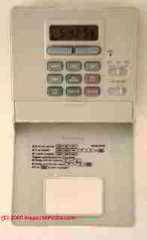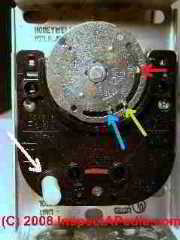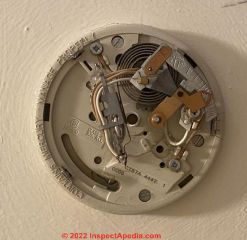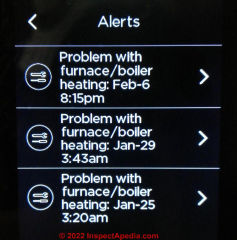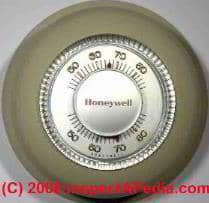 Heat Won't Turn OFF: troubleshoot the thermostat
Heat Won't Turn OFF: troubleshoot the thermostat
4 Steps to take if the heating system won't turn off
- POST a QUESTION or COMMENT about heating, air conditioning, and heat pump thermostat installation and wiring
Diagnose & fix heat that won't turn off when it should: here we discuss various causes of too much heat or of a heating system that does not shut off when it should.
We explain how to diagnose and fix thermostat switch settings, switch settings right at the air conditioner or furnace air handler, and we review thermostat wiring problems that cause a heating system or cooling system to stay ON when it should not.
We provide a sequence of diagnostic steps that determine if the problem is at the thermostat, the thermostat wiring, or at other heating or cooling system controls.
InspectAPedia tolerates no conflicts of interest. We have no relationship with advertisers, products, or services discussed at this website.
- Daniel Friedman, Publisher/Editor/Author - See WHO ARE WE?
Thermostat Troubleshooting: heating or cooling system won't turn OFF
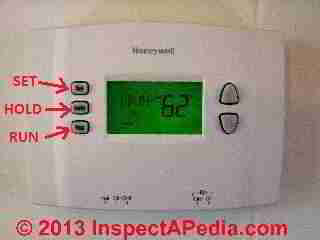 Here we discuss how to diagnose & fix a thermostat that keeps calling for heating or cooling when it should not.
Here we discuss how to diagnose & fix a thermostat that keeps calling for heating or cooling when it should not.
A separate article, HEAT WON'T TURN OFF, gives diagnostic procedures for other reasons why building heat wont' turn off besides problems at the thermostat itself.
Article Contents
- THERMOSTAT WON'T TURN OFF - page top
- STEP 1: CHANGE THE THERMOSTAT SETTING
- STEP 2: CONFIRM PROBLEM in THERMOSTAT or WIRES
- STEP 3: CHECK DAMAGED THERMOSTAT WIRES
- STEP 4: IF THE PROBLEM is NOT THE THERMOSTAT
- EXAMPLES of THERMOSTAT TROUBLESHOOTING
- HEAT WON'T TURN OFF - separate article to see if the problem is definitely not the thermostat
First Step: Change the thermostat setting up or down
If the heating system won't turn OFF, that is if heat keeps being delivered even when you don't want it, set the thermostat to its lowest temperature setting and wait three to five minutes.
Or if your thermostat has a HEAT OFF COOL or FAN AUTO OFF control, set the control to OFF or COOL.
For help locating these thermostat switches see THERMOSTAT SWITCHES, EXTERNAL.
- If the heating system stops
then the problem is most likely the thermostat setting,
See THERMOSTAT CALIBRATION
or THERMOSTAT WIRE CONNECTIONS, or external influences like position of the thermostat on the wall, exposure to drafts, etc. You might also want to
see TEMPERATURE RESPONSE of ROOM THERMOSTATS - If the heating system does not stop
continue to STEP 2 below.
Watch out: for warm air heat blower units behave differently than hot water or steam heat systems: to avoid damage to the heat exchanger the air handler or blower unit will normally keep running for a minute or even a few minutes after the thermostat has stopped calling for heat. So for warm air heating systems, give the system a few minutes to shut down.
If the air handler, blower unit, or fan won't stop,
see FAN WONT STOP - THERMOSTAT SWITCH
For hot water and steam heating systems, because the heating baseboards, convectors, or radiators will be hot and because they have some thermal mass, heat continues to be delivered for a longer interval even after the heating system itself has stopped.
Therefore to check whether or not setting the thermostat temperature down to its lowest setting (or to OFF) has turned OFF the heating system you need to listen to the heating unit itself to observe that it has stopped.
If the cooling system wont' turn OFF, that is if cool air keeps being delivered even when you don't want it, we do the opposite: set the thermostat to its highest temperature, or if your thermostat has a HEAT OFF COOL or FAN AUTO OFF control, set the control to OFF or HEAT.
- If the cooling system stops
then the problem is most likely cause of the problem was the thermostat setting,
the THERMOSTAT CALIBRATION, (including placement on the wall)
or THERMOSTAT WIRE CONNECTIONS,
or external influences. - If the cooling system does not stop
continue to STEP 2 below.
Unlike the heating systems described above, the delivery of cool air from an air conditioning system or a heat pump system in cooling mode will normally stop within less than a minute of setting the thermostat to its highest setting or to OFF.
Step 2: confirm that the problem is in the thermostat or its wiring
Forced Warm Air Heat Won't Stop
If your heating system is by forced warm air (a furnace system) then check two switches that can cause the blower fan to run continuously even if the furnace is not heating the air:
- FAN WONT STOP - THERMOSTAT SWITCH -
separate switches right on the room thermostat (photo at far left) can turn the blower fan on continuously. If you are having trouble finding switches on your thermostat
See THERMOSTAT SWITCHES, EXTERNAL. - FAN WONT STOP - LIMIT SWITCH -
a manual push-pull switch right at the limit control in the air handler (photo at close left) can set the blower fan to run continuously. If you are having trouble finding the blower assembly limit switch
See FAN LIMIT SWITCH.
While you may find good reason to keep the blower fan running continuously for now, to diagnose the problem make sure that both of these switches are set to FAN OFF.
See details
at BLOWER FAN CONTINUOUS OPERATION
Watch out: not all forced warm air furnace heating systems have a Manual-On switch on the limit switch, and not all thermostats include a FAN-ON switch on the thermostat.
All Heating Systems: forced air, warm air, hot water, steam, heat pump, electric: stuck "on" step 2 - continued
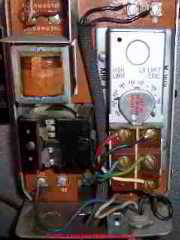 Disconnect the thermostat from the heating or cooling system - at the heating or cooling equipment.
Disconnect the thermostat from the heating or cooling system - at the heating or cooling equipment.
It's easy to isolate the room thermostat and its wiring from the heating or cooling system: we simply remove the two thermostat wires right at the primary control for the heating or cooling system involved. Typically the two thermostat wires are red and white and are connected in the controller to terminals T1 and T2.
Our photo (left) shows the red and white thermostat wires connected to a heating boiler aquastat control - look at the top left corner of the photo. [Click to enlarge this or any photo or chart seen at InspectApedia.com]
- If the heating system stops
then the problem is most likely the thermostat setting,
see THERMOSTAT CALIBRATION,
or physical THERMOSTAT WIRE CONNECTIONS, or external influences like position of the thermostat on the wall, exposure to drafts, etc.
Continue to STEP 3 below.
- If heating or cooling system keeps running
(more than a couple of minutes if you have warm air heat), something else is wrong. Since we have eliminated the thermostat we need to check for damaged or shorted thermostat wires. Continue to STEP 4 below.
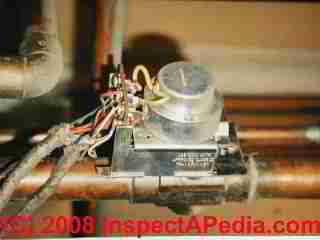 OK so it's not always as trivial as I just said. Multi-zoned heating systems may mean you have to follow the individual thermostat's wires to find just which control they operate.
OK so it's not always as trivial as I just said. Multi-zoned heating systems may mean you have to follow the individual thermostat's wires to find just which control they operate.
If you are diagnosing a heating system that is controlled by a single room thermostat, then there will be one wall thermostat, one pair of wires that run between the thermostat and a primary heater or air conditioner controller, and one primary controller at the heater or air conditioner.
Typically these are
AQUASTAT CONTROLS for hot water heat (heating boilers),
or a FAN LIMIT SWITCH for warm air heat (furnaces).
An air conditioner or heat pump will be controlled by thermostat wires connected to a control board or relay in the air handler and/or compressor/condenser unit.
But in multi-zoned heating systems there may be multiple hot water zone valves or multiple air duct zone dampers. In those systems you will need to follow the individual problem thermostat wires to the specific controller such as an individual hot water heating zone valve to make the disconnection we discuss here.
Keep in mind that a zone valve can become stuck in the OPEN position or it may even be manually latched "open" to continue to allow heat to flow.
See ZONE VALVES, HEATING
Our photo above shows a rats nest of wires at an older hot water heating system zone valve. Two of these, red and white, will be coming from the thermostat and will tell the zone valve to open on a call for heat. Additional wires from the zone valve tell the circulator pump to run.
Many room thermostats for heating and cooling have more than two wires connected to the thermostat. But in just about every case, just two wires are actually being used to turn the heater, air conditioner, or heat pump ON or OFF.
Help in sorting out thermostat wires is provided in our articles starting
at THERMOSTAT WIRE CONNECTIONS
and at THERMOSTAT WIRING COLOR CODES
and at SHORTING THERMOSTAT WIRES to ID R W B.In those articles you'll also find thermostat wiring diagrams and details for just about every type of room thermostat.
Step 3: check for damaged thermostat wiring
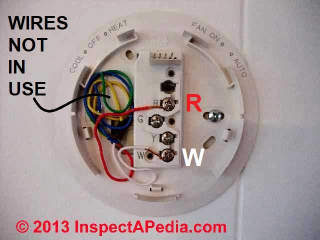
Disconnect the thermostat wires at the thermostat:
when the heat is on and running and the thermostat is set to say 68F, when the room reaches 68F (measured at the thermostat on its scale), just disconnect the thermostat wires right there at the thermostat. (See our warning at Step 2.)
Our photo (left) shows the simplest case: a red and white wire from the wall thermostat turn a heating unit on (if they are connected by the thermostat or manually by touching them together) or off if they are disconnected.
Pulling the thermostat off of its mounting plate in this instance accomplishes "disconnect the thermostat wires at the thermostat" instruction.
Since a room thermostat is basically an ON-OFF switch that calls for heating or cooling in response to room temperature, when we disconnect the thermostat itself, that's the same as NOT calling for heating or cooling.
- If the heating or cooling system stops
then the problem is most likely the thermostat setting, so
see THERMOSTAT CALIBRATION,
and seeTHERMOSTAT WIRE CONNECTIONS - at the thermostat, external influences like position of the thermostat on the wall, exposure to drafts, etc., OR the thermostat itself is defective.- For heating problems
check that you were setting the thermostat all the way DOWN and that room temperature is ABOVE the thermostat SET temperature. - For warm air heat
check that you have not set the fan control to ON at the thermostat
(FAN ON AUTO MAN Thermostat Switch) AND that you have not set the fan control to full time ON at the fan limit switch at the furnace
(FAN ON-AUTO or ON-MAN ). If the air handler, blower unit, or fan won't stop,
see FAN WONT STOP - THERMOSTAT SWITCH - Some room thermostats include a "safe" mode
that will call for heating at a pre-set temperature should the system lose power. If the thermostat requires batteries to operate, be sure that it has new fresh batteries installed. - For cooling problems
check that you were setting the thermostat all the way UP and that room temperature is BELOW the SET temperature. - And if the cooling system air handler, blower unit, or fan won't stop,
see FAN WONT STOP - THERMOSTAT SWITCH
- For heating problems
- If the heating or cooling system does not stop,
after you disconnected the thermostat wires at the thermostat, then disconnect the thermostat wires at the heating or cooling equipment again as we described
at STEP 2- If the heating or cooling system stops
then most likely the thermostat wiring is damaged, probably shorted together. Shorting the thermostat wires together is the same as a thermostat calling for the heating or cooling system to run.
If you cannot find and fix the shorted thermostat wire fault (check first around the wall thermostat and around the primary controller at the other end of the same wires) you'll need to re-wire the thermostat. - If the heating or cooling system does not stop
then the problem is not the thermostat and not the thermostat wiring.
Go to STEP 4
- If the heating or cooling system stops
Step 4: what to do when the problem is not in the thermostat or thermostat wiring
 Turn Off Electrical Power
Turn Off Electrical Power
to the Heating or Cooling Equipment. Call your heating or air conditioning service company for further diagnosis and repair help.
The equipment should STOP immediately.
Details about this switch are
at ELECTRICAL POWER SWITCH FOR HEAT
Watch out: Don't cycle heating or cooling equipment ON and OFF rapidly using the electrical power switch or any other control.
For heat troubleshooting, wait at least five minutes between on-off cycles;
For cooling system troubleshooting wait at least fifteen minutes to minimize the risk of equipment damage.
On rare occasions malfunctioning controls on heating equipment may continue to feed fuel to an oil or gas burner, requiring that fuel also be shut off. Turn off the fuel supply following instructions
at OIL or GAS FUELED HEATING EQUIPMENT SHUTOFFS.
- The primary controller on the heating system may not be working properly;
on occasion we find that the primary control on a heating system, for example an internal relay, is sticking and keeps heat on even after the thermostat has said "enough".
Depending on the type of heat your building uses your service person will check one or more primary or additional heater controllers for a stuck relay or other defects.
Details about the heating or cooling device controller operated by the thermostat depend on which type of equipment the thermostat is controlling, and are found at - If the warm air heating or air conditioning or heat pump air handler, blower unit, or fan won't stop,
see these two diagnostic procedures:
- FAN WONT STOP - LIMIT SWITCH - a manual push-pull switch right at the limit control in the air handler can set the blower fan to run continuously
- FAN WONT STOP - THERMOSTAT SWITCH - separate switches right on the room thermostat can turn the blower fan on continuously
Watch out: as we warned earlier, warm air heat blower units behave differently than hot water or steam heat systems: to avoid damage to the heat exchanger the air handler or blower unit will normally keep running for a minute or even a few minutes after the thermostat has stopped calling for heat.
For warm air heating systems, give the system a few minutes to shut down.
- Other causes of continued delivery of un-wanted heat are detailed
at HEAT WON'T TURN OFF.
Examples of Diagnosing Too Much Heat or Heat Won't Turn Off - starting at the room thermostat
Reader Question: how do I fix a thermostat that I have to set lower than the level of heat I want?
My traditional honeywell simple dial-type thermostat on the wall has two pointers and two temp. scales. However I have to set it on 60 degrees to get heat temp to 70 degrees. What can I do? It was working fine until my condo changed the air/heating system this summer. - Jeannette 1/23/2013
Reply: check these reasons for a room thermostat that keeps calling for heat
Jeannette,
On most two-scale room thermostats, one scale reads the current or actual room temperature while the other scale is the set temperature - and is adjustable.
When you move or adjust the thermostat to call for a different room temperature you will see the scale pointer move to your new setting on the "set" scale.
You are describing having to set the thermostat lower (60F) than the desired temperature (70F) to get the proper level of heat in your home. In other words, you say that the room gets too hot - hotter than you asked-for. Here are some things that would cause that problem:
- The thermostat or its wires have been damaged
and are not reliably signaling the heating system primary controller.
I wouldn't normally place this guess first, but as you think the problem began after someone worked on the system it's worth a check.
Look for a loose connection or intermittent short in wiring. For example if two thermostat wires short together that's the same as constantly calling for heat. - The thermostat is being blocked from properly sensing room heat.
That could be due to movement of the warm air supply registers to a new, more distant location, or more often, due to furniture, drapes, or even dust and crud that block the air inlet openings around the thermostat that allow it to sense room temperature.
Dust can also interfere with moving parts in older spring-type thermostats. - The thermostat is tilted out of level.
If the thermostat is an older mercury-bulb type then it needs to be level on the wall. - The thermostat is located
on a cold outdoor wall or where cold air blows on it; if your thermostat was not moved and is on an interior wall and in a draft of cold air, this isn't likely to be the cause of the problem you describe. - The primary controller on the heating system is not working properly;
on occasion we find that the primary control on a heating system, for example an internal relay, is sticking and keeps heat on even after the thermostat has said "enough".
This is easy to check. When the heat is on and running and the thermostat is set to say 68F, when the room reaches 68F (measured at the thermostat on its scale), just disconnect the thermostat wires right there at the thermostat.
If heat keeps running (more than a couple of minutes if you have warm air heat), something else is wrong. - There is some other problem
we haven't thought of.
...
Reader Comments, Questions & Answers About The Article Above
Below you will find questions and answers previously posted on this page at its page bottom reader comment box.
Reader Q&A - also see RECOMMENDED ARTICLES & FAQs
On 2022-08-14 by InspectApedia-911 (mod) - thermostat wiring problem means too much heat
@Chelsea,
If you loosen the thermostat on the wall and look on the back to see where the wires enter you should see a white and a red wire. If you follow those wires and disconnect either of them at the thermostat itself that will turn off the heat.
If the heat is still on after that then it's possible that the thermostat wires are shorted together somewhere enroute and need to be disconnected at their other end, at the controller on the heater.
On 2022-08-13 by Chelsea
Thermostat broke and I can’t figure out how to turn off the heat! Help!
On 2022-02-28 by Inspectapedia Com Moderator
@Anonymous,
Rather than re-writing our advice above, the best place to start is by going through the 4 steps listed above on this page for troubleshooting your thermostat. Not knowing anything about your heating system or wiring, that is the best first step.
For possible reasons other than your thermostat for the heat not turning off, please see
HEAT WON'T TURN OFF
Sharing your location (city and country) and what type of thermostat you have may also be useful. Feel free to add a photo of your thermostat as well.
Please let us know if you have additional questions.
On 2022-02-28 by Anonymous
We have seperate thermostat in each room one will not shut off just keep running
On 2022-02-20 by Inspectapedia Com Moderator - How do I troubleshoot a mercury thermostat?
@Darlene V Quinn,
Actually the article above on this page describes things to do when your heat won't turn off and you suspect the problem is at the thermostat. Love usually anything to do with the mercury in the thermostat it's often dust and dirt making the thermostat stick or shorted thermostat wires.
Please do take a look at the advice given on the page above. Let me know how that works for you.
On 2022-02-19 by Darlene V Quinn
I have a mercury thermostat hooked to my hot-water boiler system. The temperature is reading 75 degrees in my basement on that thermostat and the boiler keeps turning on all day and night. How do I troubleshoot a mercury thermostat? It's over 40 years old but I read mercury thermostats usually don't go bad. Thanks.
On 2022-01-25 by Inspectapedia Com Moderator
@David Louis Wert,
More likely there is a wiring error or possibly a short between two thermostat wires.
Check out the Diagnostics given on the page above.
On 2022-01-25 by David Louis Wert
new thermostat. The heater will not shut down all the time. We have to manually shut it down at the breaker. We turn thermostat off and it still will not shut down. Could we possibly have brought a bad one?
On 2021-07-13 by danjoefriedman (mod) - step through diagnostics before replacing thermostat
@Denise,
Before replacing the thermostat - as it may be perfectly fine - try stepping through the diagnostic suggestions given on the page above. It would be a shame to toss a good thermostat only to discover, while installing its replacement, that the problem lies elsewhere, such as in shorted thermostat wires or a bad A/C control board.
On 2021-07-13 by Denise
My thermostat is on auto running my air conditioner it has reach 70 degrees and normally it will shut off once the house reach that temperature but it continues to run. Is it time for me to replace my thermostat?
On 2021-06-28 by danjoefriedman (mod) - Honeywell thermostat won't turn off heat
@sarah,
You landed on the correct page for this problem. Our best and most detailed advice is given above in a sequence of steps that you can follow. I will try those and let me know what happens
On 2021-06-28 by sarah
I have a Honeywell computer chip roter it does do anything and I cannot turn the heat off it is now 91d inside my apartment.
I just do not know what to do next
On 2021-02-07 by danjoefriedman (mod) - ecobee thermostat display
Dan
Let's start with the diagnostic steps at NO HEAT - FURNACE (this assumes by "furnace" you mean that you have forced warm air heat.
If you have hot water (radiator, baseboard, steam) heat start at NO HEAT - BOILER
Let me know what you find.
On 2021-02-07 by Dan
My ecobee thermostat displays:There may be a problem with the furnace. For the past 2 hours the thermostat has been calling for heat, but the room temperature has decreased by 1.6C. Is there something wrong with the furnace?
Reader Question: possible shorted thermostat wires
Our furnace thermostat failed after an adjacent water heater installation. I noticed that wires were pinched between the water heater and the gas pipe.
After I loosened the safety straps and freed the wire, the thermostat works. (I reset the furnace).
Were squished wires the cause of a temporary short and will the wires keep working if they are undisturbed? - Larry 8/2/11
Reply: check for shorted wires and for thermostat transformer damage as well as for blown fuse
Yes it's surely possible that your thermostat wires were shorted.
Now a short in those wires sometimes lets you off the hook with no trouble, since the wires and thermostat are basically an "on-off" switch that calls for heat (or no heat).
But a thermostat wire short at the transformer could burn out the low voltage transformer that powers the thermostat and heating controls or maybe even damage the thermostat itself.
Find and check the low voltage transformer (often it's mounted near your furnace, on an electrical junction box, or it may be integral in your heater control unit).
See LOW VOLTAGE TRANSFORMER TEST
...
Continue reading at HEAT WON'T TURN OFF - topic home, or select a topic from the closely-related articles below, or see the complete ARTICLE INDEX.
Or see THERMOSTAT WON'T TURN OFF FAQs - questions & answers posted originally at this page
Or see these
Recommended Articles
- CONTINUOUS BLOWER FAN OPERATION
- FAN ON AUTO MAN Thermostat Switch
- FAN WONT STOP - LIMIT SWITCH
- FAN WONT STOP - THERMOSTAT SWITCH
- HEAT WON'T TURN OFF - topic home
- SHORTING THERMOSTAT WIRES to ID R W B
- ZONE VALVES, HEATING - a stuck zone valve can keep heat "on"
Suggested citation for this web page
THERMOSTAT WON'T TURN OFF at InspectApedia.com - online encyclopedia of building & environmental inspection, testing, diagnosis, repair, & problem prevention advice.
Or see this
INDEX to RELATED ARTICLES: ARTICLE INDEX to HVAC THERMOSTATS
Or use the SEARCH BOX found below to Ask a Question or Search InspectApedia
Ask a Question or Search InspectApedia
Try the search box just below, or if you prefer, post a question or comment in the Comments box below and we will respond promptly.
Search the InspectApedia website
Note: appearance of your Comment below may be delayed: if your comment contains an image, photograph, web link, or text that looks to the software as if it might be a web link, your posting will appear after it has been approved by a moderator. Apologies for the delay.
Only one image can be added per comment but you can post as many comments, and therefore images, as you like.
You will not receive a notification when a response to your question has been posted.
Please bookmark this page to make it easy for you to check back for our response.
IF above you see "Comment Form is loading comments..." then COMMENT BOX - countable.ca / bawkbox.com IS NOT WORKING.
In any case you are welcome to send an email directly to us at InspectApedia.com at editor@inspectApedia.com
We'll reply to you directly. Please help us help you by noting, in your email, the URL of the InspectApedia page where you wanted to comment.
Citations & References
In addition to any citations in the article above, a full list is available on request.
- [2] Thanks to reader S.R. for discussing loss of heat due to a thermostat wiring mistake, October 2010
- [3] Thank to Mr. Scott Meenen , G&S Mechanical Services , for providing some common thermostat wiring codes also found at Mr. Meenen's web page Malware Deleted 12/9/2014 . Mr. Meenan provides heating, heat pump, and air conditioning repair services in Maryland, Washington D.C., and northern Virginia. He can be contacted at 301-591-1646 or by Email to Malware Deleted 12/9/2014 - 10/2010. Quoting:
We service American Standard, Amana, Arco, Arco-Air, Bryant, Carrier, Coleman Evcon, Comfortmaker, Day/Night/Payne, Dunham-Bush, Fedders, Fredrich, Goodman, General Electric, Heil, Intertherm, ICP, Janitrol, Lennox (Armstrong, Johnson Air-Ease), Miller, Modine, Nordyne, Rheem/Ruud/Weatherking, Sears, Stewart Warner, Trane, Weather King, Williams, White-Westinghouse, Whirlpool, Weil Mclain, York, (Frasier Johnson/Borg Warner) and others. - [4] Azel Technologies Inc., P.O. Box 53138 10 Royal Orchard Blvd. Thornhill, Ontario, Canada L3T 7R9 Ph: 905-223-5567 Fax: 905-223-3778 Email: info@azeltec.com, Website: www.azeltec.com.
- [5] Honeywell Controls, the company wants you to use their contact form at this web page: http://www51.honeywell.com/honeywell/contact-support/contact-us.html
Honeywell Consumer Products, 39 Old Ridgebury Road Danbury, CT 06810-5110 - (203) 830-7800
World Headquarters, Honeywell International Inc., 101 Columbia Road, Morristown, NJ 07962, Phone: (973) 455-2000, Fax: (973) 455-4807 1-800-328-5111- Honeywell product model numbers & instruction Manuals: see http://yourhome.honeywell.com/home/Applications/FindYourModelNumber.aspx
- [6] White Rodgers Thermostats and HVAC controls,
Homeowner information: http://www.emersonclimate.com/en-US/brands/white_rodgers/Pages/wr-homeowner-info.aspx
Contractor information: http://www.emersonclimate.com/en-US/brands/white_rodgers/wr_contractor_info/Pages/white-rodgers-contractor-info.aspx
White Rodgers Product Catalog (don't misspell the company's name as White Rogers Thermostats) -
http://www.emersonclimate.com/Documents/thermostats.pdf - Thermostat Catalog - [7] White Rodgers 1F90 Low Voltage Digital Comfort-Set thermostat Installation Instructions, PN 37-3654, White-Rodgers Division, Emerson Electric Co., 9797 Reavis Rd., St. Louis MO 63123
- [8] "Automatic Oil Burner Controls - Thermostats", Domestic and Commercial Oil Burners, 3rd Ed., Charles H. Burkhardt, McGraw Hill, 1969 (and later editions), ASIN B0000EG4Y8
- [9] Thermostat wiring color codes & conventions, Thanks to reader " Helpful Pointers" Regarding 24V T, 10/7/2012
- [10] Domestic Central Heating Wiring Systems and Controls, 2d Ed., Raymond Ward, Newnes, ISBN-10: 0750664363, ISBN-13: 978-0750664363, Quoting from Amazon.com:
This unique A-Z guide to central heating wiring systems provides a comprehensive reference manual for hundreds of items of heating and control equipment, making it an indispensable handbook for electricians and installers across the country. The book provides comprehensive coverage of wiring and technical specifications, and now includes increased coverage of combination boilers, recently developed control features and SEDBUK (Seasonal Efficiency of Domestic Boilers in the UK) boilers ratings, where known.
In addition to providing concise details of nearly 500 different boilers fuelled by electric, gas, oil and solid fuel, and over 400 programmers and time switches, this invaluable resource also features numerous easy-to-understand wiring diagrams with notes on all definitive systems. Brief component descriptions are provided, along with updated contact and website details for most major manufacturers. - [11] Proliphix Corporate Headquarters [Website: proliphix.com] ,
3 LAN Drive Suite #100
Westford, MA 01886
Phone: +1.978.692.3375
Toll Free (U.S.): 866-IP-LIVING (866.475.4846)
Fax: +1.978.692.3378 - Email: sales@proliphix.com or Customer support: support@proliphix.com Website: http://www.proliphix.com/ - quoting from the company's website:
All Proliphix Network Thermostats come with our free Uniphy Remote Management Service. This unique offering lets you monitor and control your HVAC systems by simply pointing your Browser to our secure Proliphix Web Site. Enjoy the convenience of programming a thermostat from any location, using a simple graphical interface. No computer equipment or software is required. And since Proliphix takes care of the network configuration for you, you’ll be up and running in no time. We’ll even proactively monitor your thermostats and send you an immediate email or SMS message when an HVAC problem is detected. - [12] "Heating Control Handbook for the Installer and Service Man,Oil Burner, Gas Burner and Stoker Controls", Honeywell Corporation, March 1949 [copy on file as HoneywellControlsHandbookSA1399-2-1949.pdf] . Some of the controls discussed in detail here include the
- Honeywell T1 and T11A = Series 10
- Honeywell T21A (T2) = Series 20
- Honeywell T847A = Series 80
- Honeywell RA117A (RA1) = Series 10
- Honeywell LA101A = Series 10,
- Honeywell LA419A (LA4) = Series 40
- V155A = Series 10, V435A = Series 40, V575A = Series 50, V835A = Series 80
- [13] Trane TCONT800 Series Touch Screen Programmable Comfort Control Ownes Guide, American Standard, Inc., Troup Highway, Tyler TX 75711, January 2005, Telephone: Customer Service: 1-877-3381, website: www.trane.com
- Domestic and Commercial Oil Burners, Charles H. Burkhardt, McGraw Hill Book Company, New York 3rd Ed 1969.
- National Fuel Gas Code (Z223.1) $16.00 and National Fuel Gas Code Handbook (Z223.2) $47.00 American Gas Association (A.G.A.), 1515 Wilson Boulevard, Arlington, VA 22209 also available from National Fire Protection Association, Batterymarch Park, Quincy, MA 02269. Fundamentals of Gas Appliance Venting and Ventilation, 1985, American Gas Association Laboratories, Engineering Services Department. American Gas Association, 1515 Wilson Boulevard, Arlington, VA 22209. Catalog #XHO585. Reprinted 1989.
- The Steam Book, 1984, Training and Education Department, Fluid Handling Division, ITT [probably out of print, possibly available from several home inspection supply companies] Fuel Oil and Oil Heat Magazine, October 1990, offers an update,
- Principles of Steam Heating, $13.25 includes postage. Fuel oil & Oil Heat Magazine, 389 Passaic Ave., Fairfield, NJ 07004.
- The Lost Art of Steam Heating, Dan Holohan, 516-579-3046 FAX
- Principles of Steam Heating, Dan Holohan, technical editor of Fuel Oil and Oil Heat magazine, 389 Passaic Ave., Fairfield, NJ 07004 ($12.+1.25 postage/handling).
- "Residential Steam Heating Systems", Instructional Technologies Institute, Inc., 145 "D" Grassy Plain St., Bethel, CT 06801 800/227-1663 [home inspection training material] 1987
- "Residential Hydronic (circulating hot water) Heating Systems", Instructional Technologies Institute, Inc., 145 "D" Grassy Plain St., Bethel, CT 06801 800/227-1663 [home inspection training material] 1987
- "Warm Air Heating Systems". Instructional Technologies Institute, Inc., 145 "D" Grassy Plain St., Bethel, CT 06801 800/227-1663 [home inspection training material] 1987
- Heating, Ventilating, and Air Conditioning Volume I, Heating Fundamentals,
- Boilers, Boiler Conversions, James E. Brumbaugh, ISBN 0-672-23389-4 (v. 1) Volume II, Oil, Gas, and Coal Burners, Controls, Ducts, Piping, Valves, James E. Brumbaugh, ISBN 0-672-23390-7 (v. 2) Volume III, Radiant Heating, Water Heaters, Ventilation, Air Conditioning, Heat Pumps, Air Cleaners, James E. Brumbaugh, ISBN 0-672-23383-5 (v. 3) or ISBN 0-672-23380-0 (set) Special Sales Director, Macmillan Publishing Co., 866 Third Ave., New York, NY 10022. Macmillan Publishing Co., NY
- Installation Guide for Residential Hydronic Heating Systems
- Installation Guide #200, The Hydronics Institute, 35 Russo Place, Berkeley Heights, NJ 07922
- The ABC's of Retention Head Oil Burners, National Association of Oil Heat Service Managers, TM 115, National Old Timers' Association of the Energy Industry, PO Box 168, Mineola, NY 11501. (Excellent tips on spotting problems on oil-fired heating equipment. Booklet.)
- In addition to citations & references found in this article, see the research citations given at the end of the related articles found at our suggested
CONTINUE READING or RECOMMENDED ARTICLES.
- Carson, Dunlop & Associates Ltd., 120 Carlton Street Suite 407, Toronto ON M5A 4K2. Tel: (416) 964-9415 1-800-268-7070 Email: info@carsondunlop.com. Alan Carson is a past president of ASHI, the American Society of Home Inspectors.
Thanks to Alan Carson and Bob Dunlop, for permission for InspectAPedia to use text excerpts from The HOME REFERENCE BOOK - the Encyclopedia of Homes and to use illustrations from The ILLUSTRATED HOME .
Carson Dunlop Associates provides extensive home inspection education and report writing material. In gratitude we provide links to tsome Carson Dunlop Associates products and services.


